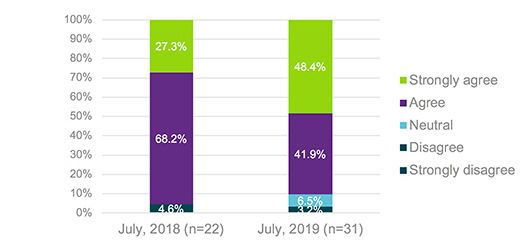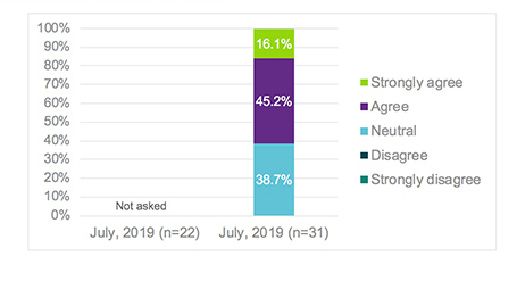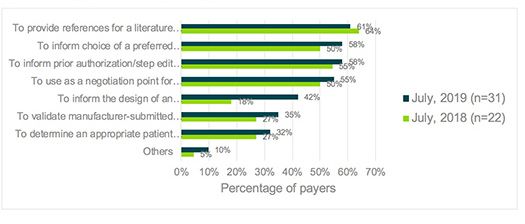Trends in Payer Reliance on ICER Assessments
In response to growing Institute for Clinical and Economic Review (ICER) activity, Jenny Lee and Eric Latch take a revised look at payer reliance on ICER assessments and perceptions on value-based pricing.
The recent influx of high-priced drugs remains a concern for many payers in the US and it has led to a discussion that prescription drug prices should reflect more accurately the level of improvement in patient outcomes.
The Institute for Clinical and Economic Review (ICER), a Boston-based independent nonprofit organization, seeks to improve healthcare value by providing comprehensive clinical and cost-effectiveness analyses of treatments, tests, and procedures.1 ICER’s value framework opened the public discourse on healthcare value by presenting transparent and scientifically rigorous information on the clinical features, as well as the long-term and short-term economic impact on the healthcare system. Over the years, there has been a jump in the number of reports issued by ICER; this has coincided with an increase in the number of high-cost therapies to treat cancer, rare diseases and chronic diseases, such as asthma and diabetes. Earlier this year, ICER announced its preliminary list of potential assessment topics for 2020. The list is drawn from ICER horizon scans of new and emerging therapies, conversations with stakeholders, and suggestions submitted by the public. The list includes, but is not limited to, breast cancer, HIV and pre-exposure prophylaxis (PrEP), lymphoma, multiple sclerosis and non-alcoholic steatohepatitis (NASH).2 ICER reports will include evidence-based calculations of prices for new drugs that accurately reflect the degree of improvement expected in long-term patient outcomes, while also highlighting price levels that might contribute to a more affordable healthcare system.
ICER launched an international collaboration earlier this year to develop new methods to guide value-based pricing. This effort will be incorporated into ICER’s 2020 value framework to improve their methodologies in assessing the comparative clinical effectiveness and value of healthcare tests, treatment and delivery system innovations.
Growing ICER activity led ICON to refresh research on payer reliance on ICER assessments and perceptions on value-based pricing over the past year, as a follow-up and update to its original research conducted in 2018.
Research methodology
ICON conducted primary research in 2018 research on payer utilization of ICER and updated this research in 2019. The research methodology consisted of a web-based survey followed by several in-depth interviews with US payers. The survey was promoted via email to an audience of more than 400 stakeholders using ICON’s Accessline database of managed care organization (MCO), pharmacy benefit manager (PBM) and Integrated Delivery Network (IDN) decision-makers. To be included in the survey, respondents had to be currently or recently (within the past two years) employed by an MCO, PBM, or IDN and be involved in making formulary and/or drug coverage decisions. Follow-up telephone interviews were conducted with four respondents to extrapolate aspects of the survey results. Descriptive statistics were used to report the survey results and are presented as percentages.
In total, 22 and 31 respondents in 2018 and 2019, respectively, (mostly medical and pharmacy directors) from unique payer organizations covering an average of 6.3 million and 6.1 million health plan lives were surveyed.
Research topics
As seen in Figure 1, payers believed there was a need for an independent, third-party HTA (Health Technology Assessment) body in the US given the increasing price sensitivity and public scrutiny regarding drug prices. Payer perception of the need for an independent HTA body in the US has increased by 77% since last year’s research.
Figure 1: Need for an independent HTA body in the US

Payers were largely familiar with ICER reports (Figure 2)and found most aspects of the report helpful, especially indicators of cost-effectiveness, comparative effectiveness, incremental cost per outcomes, and value-based benchmark prices. Payers noted coverage policy and references were the least helpful amongst the sections in the ICER reports.
Figure 2: Payer familiarity with ICER reports, processes, and assessments

As shown in Figure 3, payers also believed ICER’s influence in the pharmaceutical industry was likely to increase in the next five years as more manufacturers are paying attention to ICER reports and factoring them into pricing decision-making.
Figure 3: Payer expectations of ICER’s influence in the pharmaceutical industry for the next five years

Utilization of ICER’s cost-effectiveness
ICER’s cost-effectiveness was believed to be playing a more significant role in price negotiations with payers since its analyses inform decisions on pricing that depend on the market’s potential to bear the cost burden (Figure 4). Payers utilize ICER’s cost-effectiveness and utilization data to benchmark and assess how the market will bear the cost burden and what pricing will look like in both funded and non-funded markets. While most payers found ICER’s cost-effectiveness useful, they noted that they haven’t made a “hard line” to set a threshold where coverage will be cut off. Payers leverage ICER reports in the initial assessment phase, and if the drug falls within the cost-effectiveness threshold, they usually will not take additional steps or add other conditions in determining coverage.
Figure 4: Payer likelihood to follow an ICER’s cost-effectiveness threshold

Changes in manufacturers relying on ICER assessments
As seen in Figure 5, over 60% of surveyed payers have observed more manufacturers preparing for ICER assessments proactively and in earlier phases of research/commercial development over the past year. Manufacturers are more sensitive to pricing now and are currently looking for third-party sources where they can stay current on changes in pricing trends. Many PBMs working closely with manufacturers report that price sensitivity topics come up very often. They also note that there are more and more proactive manufacturers whose market access and managed market groups are very sensitive to pricing trends when planning their future products. An example of a manufacturer’s growing sensitivity to ICER is the launch of XELJANZ® (tofacitinib). The drug’s price was outside of ICER’s QALY. In response, the manufacturer came back with a lower price that fit within the QALY. PCSK9 inhibitors were also cited as great examples of how significant an ICER pricing analysis may be in demonstrating the true cost of a drug when it is priced too high. Last year, Amgen announced the price reduction of its PCSK9 inhibitor REPATHA®(evolocumab) by 60% from an annual price of $14,100 down to $5,850. Following this, Sanofi and Regenron matched the price reduction of their own PCSK9 inhibitor PRALUENT®(alirocumab) to $5,850/year.
Figure 5: The level of agreement of payers who see more manufacturers preparing for ICER assessments proactively and in earlier phases

Perception and utilization of ICER reports
ICER reports were most frequently used to provide references for literature reviews as part of the drug information/review process. They were also used as a negotiation point with manufacturers for rebate/pricing discussions for drugs, to inform management utilization criteria (such as prior authorization), and to inform choice of a preferred product(s) within a therapeutic class. When negotiating a rebate based on an ICER-assessed cost-effectiveness threshold, some payers requested a rebate of ~25% or less of the difference between the product list price and the ICER-assessed cost-effectiveness threshold while others have asked for a larger rebate of up to 49%.
Payers noted that they utilize ICER reports during P&T review and clinical policy development. According to one national payer, ICER reports were typically used in the fall for contracting with manufacturers and in the spring for reevaluation, to assess performance, budgeting cycle, and impact of agreement.
Figure 6: How payers are utilizing ICER reports

Conclusions
Through this research, ICON saw a marked increase in payer awareness and acceptability of ICER. We noted that a larger number of payers use ICER assessments and cost-effectiveness benchmarks when evaluating coverage of new drugs over the past year. The majority of payers’ perspectives on ICER have evolved over time; one payer stated, “ICER continues to grow in esteem of payers due to a growing desire to have good cost-effectiveness data which will be a greater driver of drug access in the future than it has been before in the US.”
However, uncertainty around ICER’s assessment methodologies and organizational independence have remained a concern for some payers. Along with ICER’s rise to prominence over the last few years, there has been an increase in discussions around how to create wider market awareness on its value framework initiative and maintain its value and credibility as an independent body to justify or support formulary recommendations. Undoubtedly, we will continue to hear more about ICER’s influence particularly on new and emerging therapies. ICER President Steven D. Pearson, MD, MSc, explained, “Since our inception, ICER has strived to combine state-of-the-art academic methods of technology assessment with procedures that create structures for active engagement of all stakeholders and that ultimately achieve the highest level of transparency possible. We will stay willing to change. We will listen constantly to those engaged in our reviews and to explore ways to change our methods to keep evolving and improving.”3
Jenny Lee, PharmD, MBA, MPH, is Consultant, Global Pricing & Market Access, and Eric Latch, MS
is Senior Analyst, Global Pricing & Market Access, both at ICON.
References
[1] L. T. Pizzi, The Institute for Clinical and Economic Review and tis Growing Influence on the US Healthcare, Am Health Drug Benefits. 2016 Feb; 9(1): 9-10.
[2] The Institute for Clinical and Economic Review, https://icer-review.org/about/
[3] ICER Propose Updates to 2020 Value Assessment Framework Methods and Procedures, https://icer-review.org/announcements/2020vaf_proposed_updates/
Trump: 'Major Tariff' on Pharmaceuticals Coming Soon
Published: April 9th 2025 | Updated: April 9th 2025“We’re going to tariff our pharmaceuticals, and once we do that, they are going to come rushing back into our country," President Donald J. Trump said during a Tuesday night dinner in Washington.